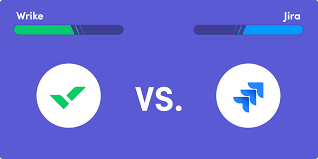Table of Contents
- Introduction
- What is Wrike?
- What is Jira?
- Wrike vs Jira: Key Feature Comparison
- Which Tool is Better for Agile Teams?
- Which Tool is Better for Development Teams?
- Pricing Comparison
- Pros and Cons
- Frequently Asked Questions
- Conclusion
In today’s fast-paced digital world, having the right tools for project management can make or break your team’s productivity. For Agile and software development teams, tools like Wrike and Jira are two of the most popular solutions. But how do you choose between them?
Both platforms promise to improve collaboration, manage sprints, and streamline workflows, yet they cater to different needs and styles. In this comprehensive comparison, we’ll help you decide whether Wrike or Jira is the better fit for your project team.
What is Wrike?
Wrike is a cloud-based project management tool known for its flexibility and user-friendly interface. It’s designed to support marketing, creative, product, and Agile teams with features such as:
- Task and project planning
- Custom workflows
- Time tracking
- Gantt charts
- Integration with over 400+ apps
Wrike appeals to teams looking for a balance between structured project management and flexible collaboration.
What is Jira?
Jira, developed by Atlassian, is a specialized tool for software development and Agile teams. Originally designed for issue tracking, it’s now a full-fledged Agile project management platform.
Key features include:
- Scrum and Kanban boards
- Advanced reporting (e.g., burndown charts, velocity reports)
- Custom workflows
- Robust permission controls
- Seamless integration with development tools like Bitbucket and GitHub
Jira is a go-to for developers, DevOps teams, and Agile practitioners.
Wrike vs Jira: Key Feature Comparison
| Feature | Wrike | Jira |
|---|---|---|
| Agile Boards | Available (limited) | Advanced (Scrum, Kanban) |
| Gantt Charts | Built-in | Available via plugins |
| Time Tracking | Native | Via third-party add-ons |
| Reporting & Analytics | Visual dashboards | Agile-specific reporting |
| Task Dependencies | Yes | Yes |
| Custom Workflows | Yes | Yes |
| Integration Options | 400+ (Google, Slack, Zoom) | Dev-focused (GitHub, Bitbucket) |
| Ease of Use | Beginner-friendly | Steeper learning curve |
| Target Audience | General teams, marketing | Developers, Agile teams |
Which Tool is Better for Agile Teams?
Jira wins when it comes to Agile project management. Here’s why:
- Native Scrum and Kanban Boards: Ideal for sprint planning and backlog grooming.
- Agile Reports: Access to burndown charts, velocity, and sprint forecasting.
- Custom Workflows: Tailored for Scrum, SAFe, and other Agile methodologies.
However, Wrike supports Agile too, just with a more visual and less technical approach. It’s suitable for non-developer Agile teams.
Which Tool is Better for Development Teams?
Again, Jira leads for software development due to:
- Issue tracking and ticketing with version control integration.
- Code-friendly integrations (Bitbucket, GitHub, Jenkins).
- DevOps support with automation and CI/CD tools.
Wrike can handle product development workflows but lacks native developer tools.
Pricing Comparison
| Plan Type | Wrike | Jira |
|---|---|---|
| Free Plan | Yes (limited features) | Yes (up to 10 users) |
| Basic Paid Plan | $9.80/user/month | $7.75/user/month |
| Business Plan | $24.80/user/month | $15.25/user/month |
| Enterprise Options | Yes | Yes |
Note: Prices are subject to change. Always check the Wrike pricing page and Jira pricing page for the most accurate details.
Pros and Cons
Wrike Pros
- Easier learning curve
- Great for visual planning and marketing teams
- Built-in time tracking and Gantt charts
Wrike Cons
- Limited Agile-specific features
- Less suited for complex development workflows
Jira Pros
- Excellent for Agile and software development
- Advanced reporting and customizable boards
- Seamless integration with code repositories
Jira Cons
- Can be overwhelming for beginners
- Requires configuration and training
Conclusion
Choosing the right tools for project management is essential for productivity and team alignment. If you’re a software development team working in an Agile environment, Jira is the clear choice with its robust features, integrations, and Agile-native design.
However, if you’re a marketing team, creative group, or a business looking for a more visual, intuitive platform, Wrike offers a more accessible option with flexible project views and user-friendly tools.
Also Read: How to Choose the Right Productivity Software for Your Remote Team in 2025
Frequently Asked Questions
1. Can Wrike support Agile methodologies?
Yes, Wrike supports Agile workflows but lacks the depth Jira offers. You can create Kanban-style boards and custom workflows, but it’s more basic.
2. Is Jira only for developers?
Not necessarily. While Jira is favored by developers, it can be configured for business and support teams too—though the interface is more technical.
3. Which is better for marketing teams?
Wrike is generally better for marketing and creative teams due to its visual interface and easy-to-use features.
4. Can I integrate both tools with Slack or Google Workspace?
Yes, both Wrike and Jira offer integrations with Slack, Google Drive, and other popular productivity tools.
5. Which tool offers better reporting features?
Jira provides Agile-specific reports, while Wrike offers visual dashboards. The better choice depends on your reporting needs.



I very delighted to find this internet site on bing, just what I was searching for as well saved to fav